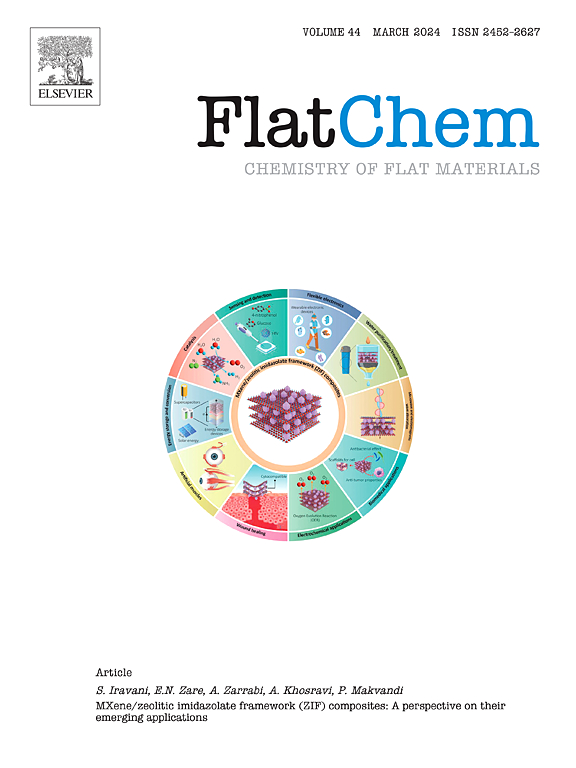A full carbon-based thermoplastic photocatalyst for organic pollutants abatement: An experimental and computational study
IF 5.9
3区 材料科学
Q2 CHEMISTRY, PHYSICAL
引用次数: 0
Abstract
Remediating water pollution utilizing inorganic semiconductor photocatalysts represents the prevailing standard for sustainable depollution. However, the applicability of this method is impeded in underground environments, low Earth orbit outposts, and future lunar bases due to the scarcity of essential materials and the logistical challenges associated with supply provision. Within this framework, developing photocatalytic systems utilizing on-site accessible resources or repurposing plastic or bio-waste materials is deemed more advantageous. In particular, a hybrid fully carbon-based material incorporating a bio-derived chromophore may leverage the electronic interactions between the carbon moiety and the chromophore antenna to induce photocatalytic processes. In the present study, a porphyrin-reduced graphene oxide photocatalytic system was developed through a one-pot synthesis method, allowing the simultaneous covalent attachment of 5,10,15,20-tetrakis-(p-hydroxyphenyl)-porphyrin to the graphene oxide platform while concurrently reducing the latter. To prevent the dispersion and self-aggregation of the powder during water depollution treatments, the carbon-based photocatalyst was further integrated into polyvinyl acetate using an in-situ polymerization approach, producing various nanocomposites with different weight percentages of photocatalyst loads. The obtained products were characterized by infrared, Raman, absorption and fluorescence spectroscopies, electrochemical analysis, and thermogravimetric analysis. Photocatalytic tests, performed with both solar simulating and visible light (>400 nm), showed that the nanocomposites could act efficiently as sequestering agents and photocatalysts for organic pollutants. Finally, computational studies were performed to verify the spectroscopic features of the system and elucidate its photocatalytic mechanism. These studies demonstrated that the constructed photocatalytic system induced a planarization of the porphyrin structure, significantly enhancing its photocatalytic performance by increased light absorption, more efficient charge separation, and greater structural stability, collectively contributing to more robust and efficient catalytic cycles in the observed photocatalytic process.

一种用于有机污染物减排的全碳基热塑性光催化剂:实验和计算研究
利用无机半导体光催化剂修复水污染代表了可持续去污染的主流标准。然而,这种方法的适用性在地下环境、近地轨道前哨站和未来的月球基地受到阻碍,因为基本材料的稀缺性和与供应供应相关的后勤挑战。在这个框架内,利用现场可获得的资源或重新利用塑料或生物废物材料开发光催化系统被认为是更有利的。特别是,包含生物衍生发色团的杂化全碳基材料可以利用碳部分和发色团天线之间的电子相互作用来诱导光催化过程。在本研究中,通过一锅合成方法,开发了卟啉还原氧化石墨烯光催化体系,使5,10,15,20-四-(对羟基苯基)卟啉同时共价附着在氧化石墨烯平台上,同时还原后者。为了防止粉末在水净化处理过程中分散和自聚集,采用原位聚合方法将碳基光催化剂进一步整合到聚醋酸乙烯酯中,制备出不同重量百分比光催化剂负载的纳米复合材料。通过红外光谱、拉曼光谱、吸收光谱和荧光光谱、电化学分析和热重分析对所得产物进行了表征。在模拟太阳和可见光(>400 nm)下进行的光催化测试表明,纳米复合材料可以有效地作为有机污染物的隔离剂和光催化剂。最后,通过计算研究验证了该体系的光谱特征,并阐明了其光催化机理。这些研究表明,所构建的光催化体系诱导了卟啉结构的平整化,通过增加光吸收、更有效的电荷分离和更高的结构稳定性,显著提高了卟啉的光催化性能,共同促进了所观察到的光催化过程中更稳健和高效的催化循环。
本文章由计算机程序翻译,如有差异,请以英文原文为准。
求助全文
约1分钟内获得全文
求助全文
来源期刊

FlatChem
Multiple-
CiteScore
8.40
自引率
6.50%
发文量
104
审稿时长
26 days
期刊介绍:
FlatChem - Chemistry of Flat Materials, a new voice in the community, publishes original and significant, cutting-edge research related to the chemistry of graphene and related 2D & layered materials. The overall aim of the journal is to combine the chemistry and applications of these materials, where the submission of communications, full papers, and concepts should contain chemistry in a materials context, which can be both experimental and/or theoretical. In addition to original research articles, FlatChem also offers reviews, minireviews, highlights and perspectives on the future of this research area with the scientific leaders in fields related to Flat Materials. Topics of interest include, but are not limited to, the following: -Design, synthesis, applications and investigation of graphene, graphene related materials and other 2D & layered materials (for example Silicene, Germanene, Phosphorene, MXenes, Boron nitride, Transition metal dichalcogenides) -Characterization of these materials using all forms of spectroscopy and microscopy techniques -Chemical modification or functionalization and dispersion of these materials, as well as interactions with other materials -Exploring the surface chemistry of these materials for applications in: Sensors or detectors in electrochemical/Lab on a Chip devices, Composite materials, Membranes, Environment technology, Catalysis for energy storage and conversion (for example fuel cells, supercapacitors, batteries, hydrogen storage), Biomedical technology (drug delivery, biosensing, bioimaging)
 求助内容:
求助内容: 应助结果提醒方式:
应助结果提醒方式:


